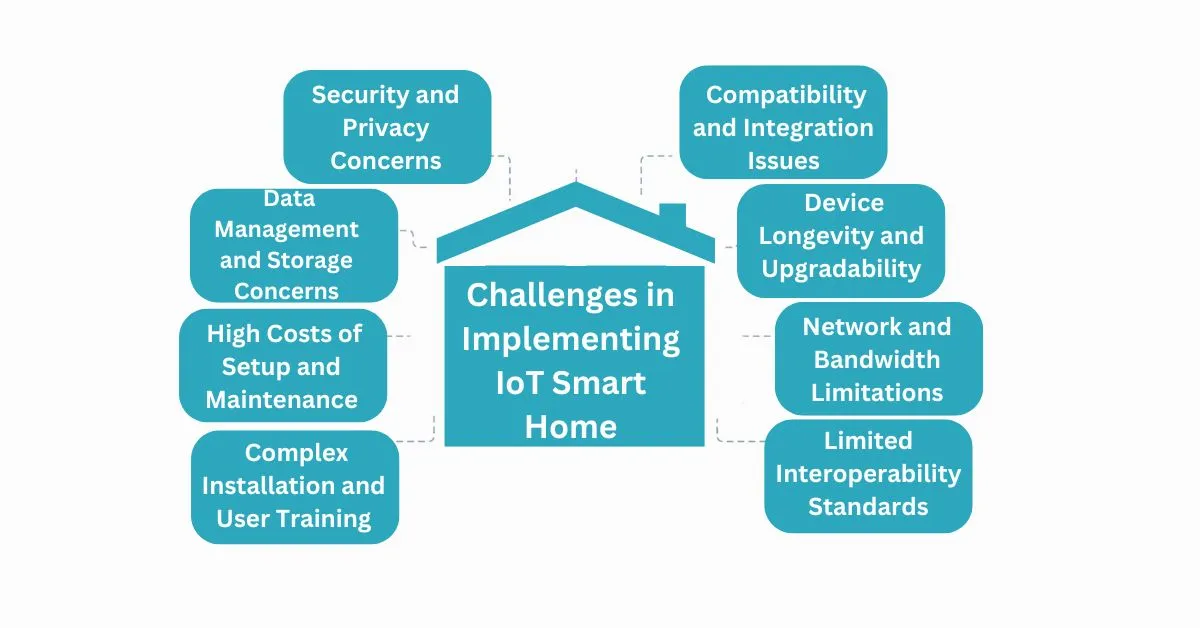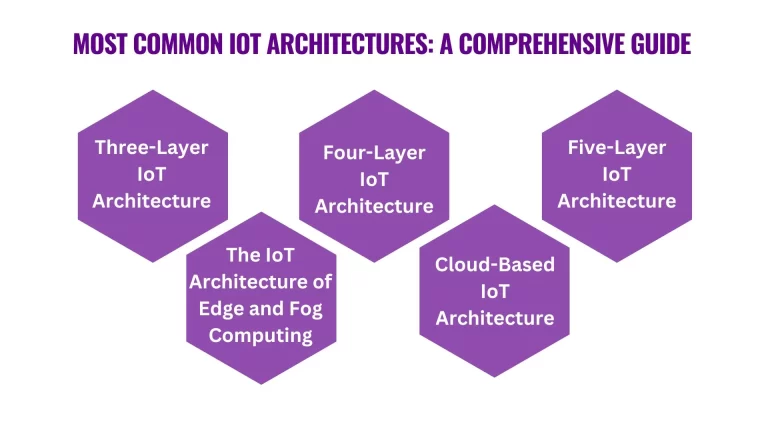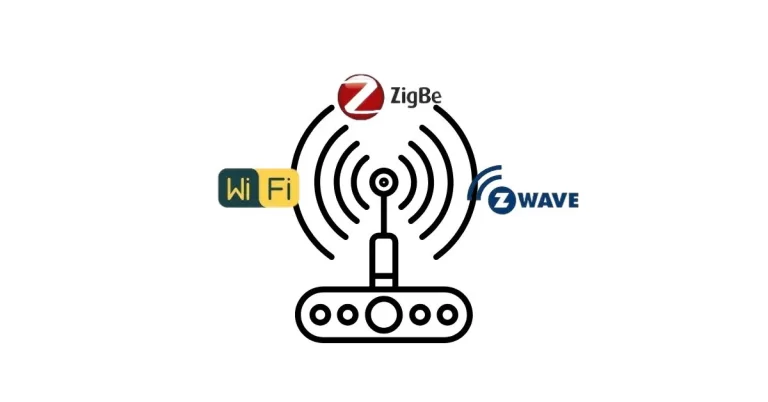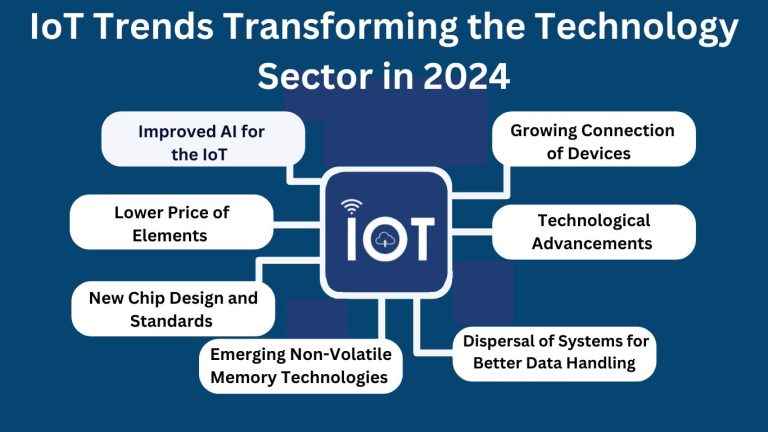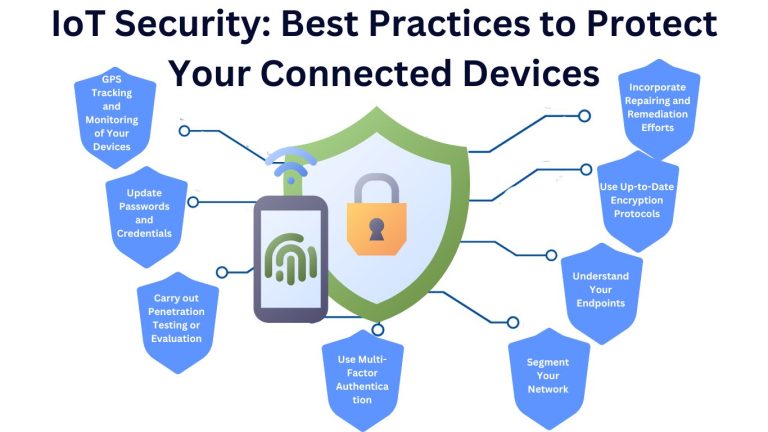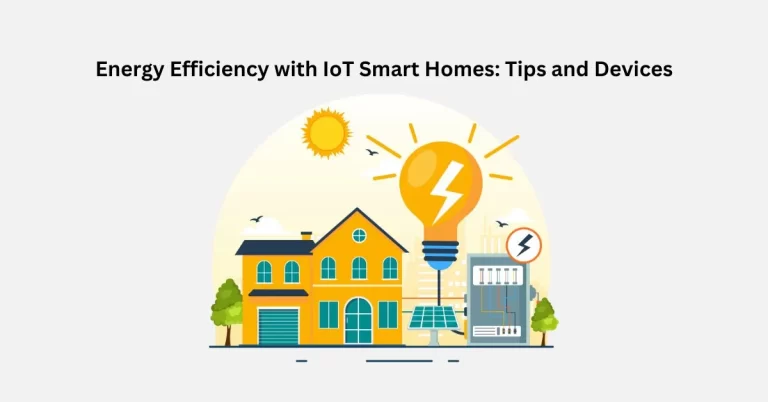Challenges in Implementing IoT Smart Homes Technology : From Privacy to Connectivity
IoT is changing both homes and workplaces. It enables the management and connectivity of almost any device, starting with smartphones and computers, home appliances, and ending with industrial equipment . There are a lot of challenges in implementing IoT smart home technology.
It is usually described as a driver of the “next industrial revolution”.
Initial projections anticipated that approximately 49.5 billion devices would be IoT-enabled by 2020, though this figure was later refined to an estimated range of 36-41 billion devices. Current projections indicate that this number will likely reach multiple billion by 2025.
IoT in Smart Homes
IoT applications are now moving into new domains, continuing the concept of “connecting the dots” and trying to bring IoT automation to industries that have not embraced these technologies yet. There are great opportunities for improving the quality of life in smart homes using IoT, but there are also great challenges and difficulties in implementing IoT smart home technologies. Mitigating these challenges is central to achieving secure, dependable and user-centric IoT-enabled homes that can offer sustainable value.
Why does IoT Smart Home Technology face Challenges?
The advantages of IoT in smart homes automation and real-time control have their challenges embedded in them. The use of IoT devices in daily life requires coordination of the connected systems, various devices, and continuous data exchange. All these aspects come with their own problems such as security, compatibility, energy consumption, and costs. It is crucial to address these factors to optimize smart home systems and make them more robust for use.
Challenges IoT Smart Homes Face
Challenges in Implementing IoT Smart Home Technology in Detail Given Below

1. Security and Privacy Concerns
Cybersecurity and privacy are important in IoT smart homes, as every individual device creates an opportunity for hackers. Hacking is probable to every smart connected device in the world. Security concerns are most apparent in smart locks, surveillance cameras and voice activation products including those that can be hacked, putting the security of the entire home at risk.
Privacy remains a concern too. Smart home devices capture enormous user data that also consists of personal details of the user and the device’s occupants are engaged in, including routines, locations, and preferences. Lack of proper management or violations of this data presents various risks to data privacy. Security and Privacy Concerns are on Top in List of Challenges in Implementing IoT Smart Home Technology
Solution
Implement strong encryption and multi-factor authentication.
2. Compatibility and Integration Issues
IoT technology is expected to create a harmonious ecosystem but its compatibility with different devices remains a major issue. Different manufacturers often employ unique communication protocols (e.g., Zigbee, Z-Wave, Wi-Fi), which unite devices into one cohesive ecosystem. This absence of a specific format (which is followed for integrating these devices) can complicate the smart home arrangements, due to compatibility issues between devices of different brands. Compatibility and Integration Issues are on 2 in List of Challenges in Implementing IoT Smart Home Technology
Solution
Use cross-compatible platforms like the Matter protocol to unify device communication.
3. Network and Bandwidth Limitations
High-speed broadband connectivity is important for IoT in smart homes to work as expected. However, when there are several devices in a single network, the bandwidth requirements can easily increase significantly. High traffic congestion can arise when many devices connect to the home Wi-Fi networks, thus bringing response time into question while at the same time decreasing device capability and finally user satisfaction.
Solution
Upgrade to mesh networks or dual-band routers for smoother connectivity.
4. High Costs of Setup and Maintenance
Adopting IoT in homes is potentially costly especially when it requires the purchase of expensive devices, controllers and advanced security systems. Constant reinforcement, including software and hardware maintenance, and network reinforcements is expensive. In the case of smart homes, the first and ongoing costs that families have to incur to build and run a smart home are a major turn-off. High Costs of Setup and Maintenance are on 3 place in List of Challenges in Implementing IoT Smart Home Technology
Solution
Budget for long-term savings and choose cost-effective devices and systems.
5. Power consumption and energy management
IoT devices are designed to use less energy than conventional systems while performing operations, but their ability to standby constantly to respond instantly to signals may hamper the total power consumption. Controlling the power needs of multiple connected devices requires a lot of thought in order to achieve the best balance of efficiency and performance. Power consumption and energy management are on 3 place in List of Challenges in Implementing IoT Smart Home Technology
Solution
Optimize power settings and automate device shutdown when not in use.
6. Limited Interoperability Standards
Fragmentation of IoT devices and platforms causes difficulty regarding the creation of uniform rules for smart home integration. Closed standards used by various manufacturers may prevent devices from interacting with each other, which may slow down the growth and development of IoT technology in home automation. People may have to spend on devices that are compatible with the ecosystem to avoid the need to switch between different ecosystems. Limited Interoperability Standards are on 6 place in List of Challenges in Implementing IoT Smart Home Technology
Solution
Adopt open standards to allow seamless integration across various systems.
7. Complex Installation and User Training
Smart home equipped with IoT requires complex configurations that are usually not easy for the average consumer to handle. Most devices need proper settings, new software installations, and constant fixing. Also, users need to understand different applications and interfaces to control these devices. Lacking formal instructions or supervision or training, the users might not get proper value from the technology being implemented. Complex Installation and User Training are on 7 place in List of Challenges in Implementing IoT Smart Home Technology
Solution
Simplify interfaces and provide comprehensive user tutorials.
8. Device Longevity and Upgradability
Most IoT devices have short lifetimes, which can be endorsed to the constant technological advancement and software dependence. In the long run, manufacturers are always likely to drop support for the hardware; making the device either useless or non-compatible with new networks. This raises questions on the long-term value and return on investment in IoT. Device Longevity and Upgradability are on 8 place in List of Challenges in Implementing IoT Smart Home Technology
Solution
Choose devices with regular software updates to ensure longevity and compatibility.
9. Data Management and Storage Concerns
Smart homes produce large amounts of data in a single day. Managing, storing and analyzing this data is an effective solution which is rather challenging. The issue of privacy regulations means that there must be secure storage capacity to meet the goal, and this is where storage security comes in. Regulations for handling personal data further complicate the task of managing IoT in smart homes.
These challenges to implementation will have to be solved as the technology develops to ensure that the smart homes created are not only secure and efficient but also easy to use to make smart home solutions sustainable. Data Management and Storage Concerns are on 9 place in List of Challenges in Implementing IoT Smart Home Technology
Solution
Invest in secure cloud storage with efficient data management practices.
Challenges in Implementing IoT Smart Home Technology in Picture
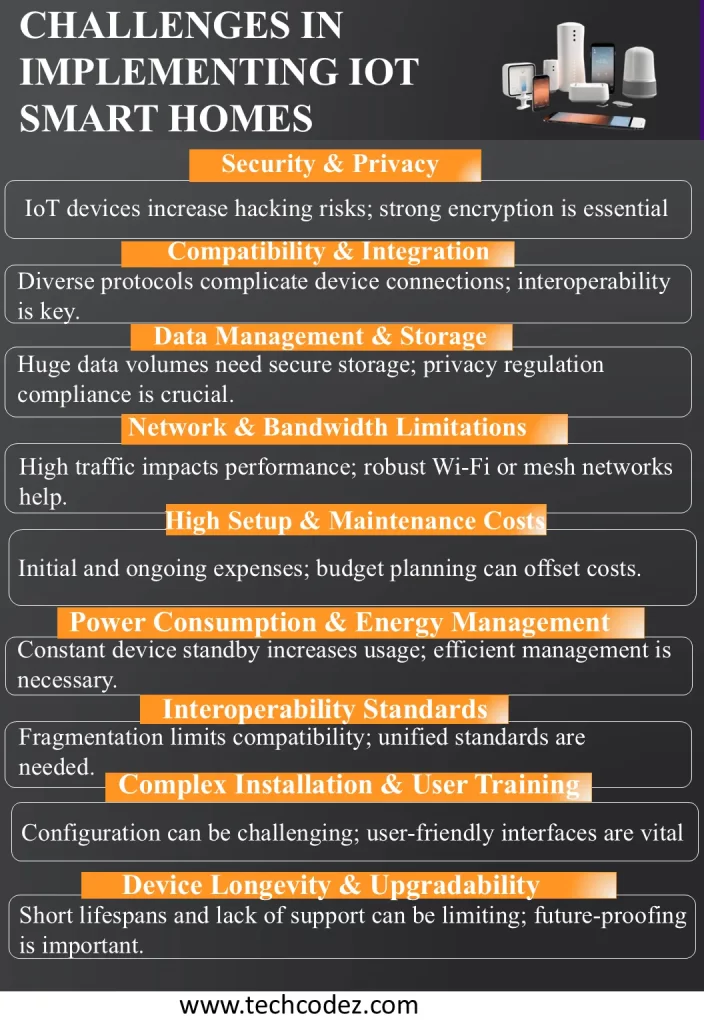
Challenges vs Solutions
Challenges in Implementing IoT Smart Home Technology Vs Solutions in Single Graph
| Challenge | Impact on Smart Homes | Solution |
|---|---|---|
| Security and Privacy Concerns | Risk of hacks and data leaks | Use strong passwords and encryption |
| Compatibility and Integration Issues | Devices may not connect seamlessly | Adopt universal protocols like Matter |
| Network and Bandwidth Limitations | Slow connectivity with multiple devices | Upgrade to dual-band routers, use mesh networks |
| High Costs of Setup and Maintenance | Expensive initial and ongoing costs | Plan phased setup, seek discounts |
| Power Consumption and Energy Management | Higher energy bills | Use energy-efficient devices, automate settings |
| Limited Interoperability Standards | Fragmented device compatibility | Invest in devices with open standards |
| Complex Installation and User Training | Setup challenging for non-technical users | Provide clear guides and tutorials |
| Device Longevity and Upgradability | Devices become outdated quickly | Choose upgradeable brands |
| Data Management and Storage Concerns | High data storage and privacy needs | Use secure cloud storage and follow regulations |
The Future of IoT in Smart Homes
The future IoT smart homes are expected to be integrated with artificial intelligence, where the devices will be able to predict when they need maintenance or when they will fail. Better ways of managing data blockchain will be available; better standards will enable better interoperability of devices.
Enhanced user awareness, cheaper IoT devices, and the use of artificial intelligence in the security of smart homes will make IoT for smart homes more secure, cheaper and sustainable.
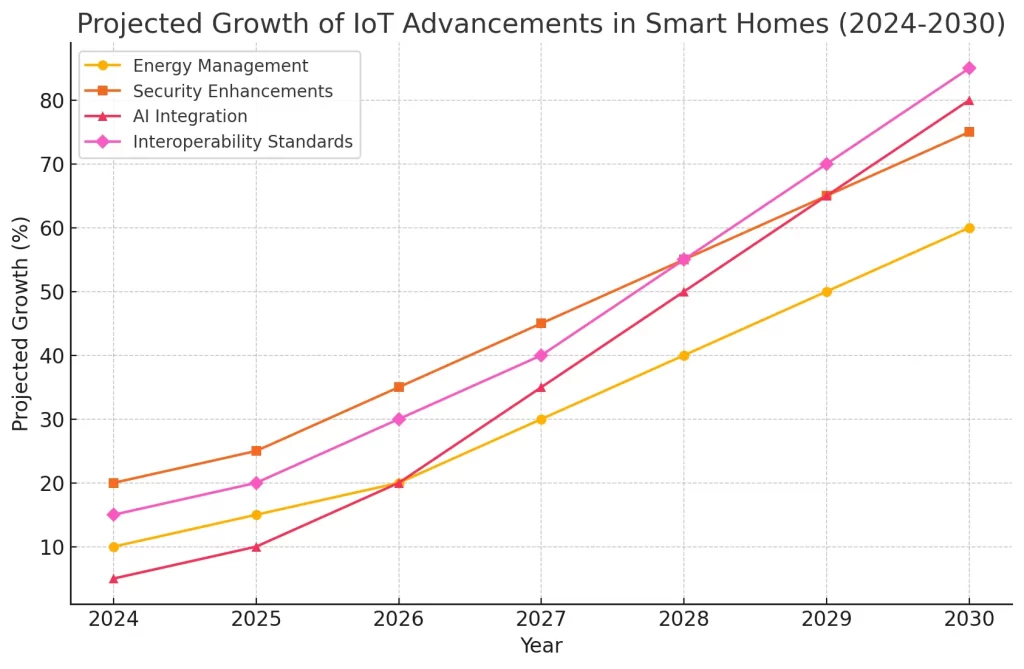
Addressing Challenges in Implementing IoT Smart Home Technology
While having Challenges in Implementing IoT Smart Home Technology we have several strategies can help to address these issues:
Enhanced Security Measures
- The IoT devices can be protected from unauthorized control by employing the use of complex passwords and authentication techniques such as two-factor, and encrypted communication methods.
Interoperability Efforts
- Current efforts of the smart home industry to develop a common platform like Matter protocol are in progress to make the smart home ecosystem more compatible for devices integration.
Network Upgrades
- There exists specialized routers in the market with dual-band or tri-band capacity that can handle traffic and integration of mesh networks is advisable to avert congestion.
Energy Management Solutions
- The use of energy-efficient devices and automation settings can be implemented to prevent power wastage and to increase efficiency.
Regular Software Updates
- It is good practice that IoT devices should have the latest firmware/software loaded which will help in improving security as well as integration with other devices.
These are top 4 several strategies can help to address Challenges in Implementing IoT Smart Home Technology.
FAQs
What are the dominant security threats in IoT smart homes?
Security threats in IoT smart homes are; intrusion, data theft and manipulation, and device tampering. The above-distinguished risks call for strong encryption practices, secure networks, and frequent updates of software to counter the probable threats.
Is it expensive to maintain an IoT Smart Home?
Of course, IoT smart home maintenance can be expensive due to the initial investment in smart home networks and constant costs for software updates, security patches, and maintenance. These costs are actually manageable if one has undertaken careful planning and budgeting.
What is the main challenge when it comes to the use of IoT?
The most important consideration when it comes to IoT is security. Lack of security measures, poor updates, privacy issues, and network vulnerabilities are also very dangerous. Preventing these areas is crucial for developing robust IoT systems in smart home environments.

